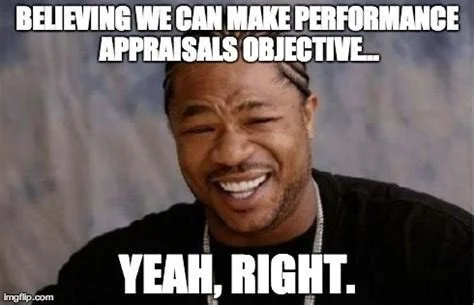A Conscious Uncoupling - Performance and Pay
We are going into the Way Back Machine today. Okay, maybe not the literal Way Back Machine, but call this a throwback moment. Today we are talking about performance management. I use throwback language here because what we know about performance management NOW is not that different than the PAST.
· Performance management was originally designed to increase productivity in agriculture and manufacturing, not the current workplace. For more information, ask ChatGPT: What is the history of performance management in the workplace?
· Bureaucracy and red tape are rampant in many performance management systems. The system of completing forms is cumbersome. Ratings systems are rarely equitable. Watch a funny example here.
· People are not great at giving feedback, and much of this feedback is subjective and based on the manager’s own situation versus the employee’s performance. Listen to a podcast here.
· Many businesses use performance management to allocate pay increases and identify high potential employees at the cost of decreasing employee engagement. See the SHRM take here.
So, why do we continue with this antiquated process? Most leaders would say that they need ways to measure employee performance, administer pay increases, and identify high potential candidates. Pay and development opportunities are key motivators. But what if we dreamed bigger with performance management? What if we flipped this archaic approach on its head and did something phenomenal instead?
I have countless conversations with clients about a “conscious uncoupling” of pay and performance. You can detach pay from performance ratings and still motivate people. You can open up new and more predictable pathways to increase pay without a cumbersome form or series of approvals. This is possible. Read on for the newest practices in performance management. Dare I say that you might get excited about this topic again? Here’s hoping.
Most performance management processes include an evaluation. This may be a simple form or online system that annually asks an employee to provide a summary of accomplishments, goals for the following year, and dreams of future development. Typically, the manager then reviews the evaluation and provides feedback and probably a rating. The employee and manager then have a meeting to discuss the feedback, sign the form, and check the completion box for senior leadership.
As a supervisor, what is your process for giving feedback to your employees in this process? What is your process for ratings? Ideally, you work in a business where supervisors have peer sessions to converse and calibrate ratings. And I bet you don’t work in a space like that. I don’t see many businesses operating like this even if that is the documented process. Typically, too many other things are happening that seem more important at the time, so we just go through the motions and push through the evaluations without hurting too many feelings. Sound familiar?
Nothing about this process is objective. As humans, our ability to give meaningful feedback can fluctuate by the day. Timing, team dynamics, money, pressure, and personal matters can all influence how we give feedback and ultimately rate performance. Did a person screw up a big project yesterday even though they are a consistent performer? The employee and supervisor are more prone to give a negative rating the next day due to recency bias.
Some great resources to dig deeper are included in this CultureAmp article. In the meantime, what are some ways to dream bigger than subjective performance feedback and ratings?
1. Change the frequency.
2. Change the questions.
3. Change the design.
First, you can change the frequency by moving from an annual review to quarterly discussions that automatically feed into the annual review. Quarterly discussions allow the employee and supervisor to discuss situations as they are happening, which provides opportunities for more meaningful and timely feedback. Second, you can change the questions on the evaluation form. Move from open boxes to more defined prompts and a mix of quantitative and qualitative questions. Find some great and easy to implement ideas in this Harvard Business Review article.
Finally, you can change the design of your overall process. Focus on strengths rather than weaknesses. Use team retrospectives to harvest group learnings. DITCH YOUR RATINGS SYSTEM. Okay, I’m a bit passionate about that last one, but you get the point. I bet that once you start the discussion about changing the performance management process at your business, others will get excited and have lots of ideas. Less is more than likely more here. And ultimately, you will increase your productivity and employee engagement. It’s a win-win.
If you make radical changes to your performance management process (or even eliminate it), then how do you identify high potentials in your organization? That’s a great question. First, let’s define high potentials for everyone. High potentials are typically your superstar employees, people who receive the highest ratings each year. Sometimes bias can creep into the high potential definition and include employees who get along with everyone, sign up for every opportunity, and work insane hours.
Companies focus on high potentials as a way to grow their internal talent pipeline, and this is super smart. It is more valuable to hire from within (when possible) than to hire externally for two main reasons. First, internal talent already know the organization which decreases onboarding time and increases trust within the organization. Second, the cost and time to recruit external talent doesn’t always equate to employee success and retention.
Some of you may be thinking that your company isn’t big enough to focus on internal talent pipelines and high potentials. That is NOT true. Maintaining and developing your employees is your most important job. Employees just don’t naturally stay in jobs for decades now. Employees need to see growth and opportunities to stay with your company.
So, back to my original question: how do you identify high potentials in your organization within a radically different performance management process? Here are three options. Each of these options may vary based on the size of your company and your HR capacity.
1. Use a pay band system with clear expectations. Typically, a company has a pay band system that provides salary ranges for roles at different levels within the company. You can work on this pay band system to identify how employees can grow in their salary band without performance ratings. Then you can use these areas within the salary band to identify high potentials based on these qualifications. See my video this month to learn more.
2. Offer optional cross-company opportunities with clearly defined roles & expectations. Do you have a project happening right now that cuts across the entire company? Then ask a high potential employee to join the project and serve in some capacity. Maybe it’s reviewing materials or notetaking or whatever. Just be clear why this employee is joining the project and what you expect them to learn. Additionally, help the high potential employee to decrease their own workload a bit so it’s not extra work without pay. AND check-in regularly.
3. Give regular leadership training opportunities. Typically, a high potential is identified because of their leadership potential. I’ve seen clients offer leadership training opportunities in many ways. One group offers a leadership academy every 2-3 years, which is led by senior leadership. Another group hires a leadership coach to work with a group of high potentials in developing self-awareness. I have even seen clients ask their high potentials to attend a training together and spend the next day debriefing their learnings with a senior leader.
Each of these options provide flexibility and autonomy, which are key factors in employee engagement. Plus, two of these options propose high potentials spending direct time with senior leadership. Get creative. Ask your high potentials what they need to grow.
What happens when you consciously uncouple pay from performance? Spoiler alert: your organization will not die. In this 11-minute video, Sally Loftis, MSOD (she/her/hers) describes a multi-lane process for increasing pay that promotes predictability, transparency, and financial sustainability.


